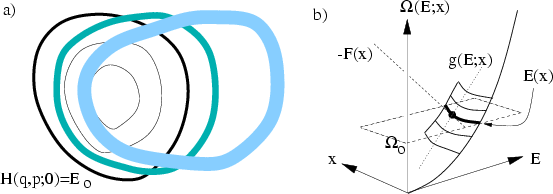Here I review the mechanism for dissipation in
a classical ergodic system whose Hamiltonian is
dependent on an external parameter ![]() .
An example model to keep in mind
is that of a gas particle trapped inside a deformable chaotic cavity,
where heating of the particle (increase in
expectation value of the particle kinetic energy) can occur
due to time-dependent deformation (driving).
Note that
the cavity wall is ``cold'', i.e. there are no
thermal fluctuations in its velocity.
Heating rate in the cavity case will be discussed in detail in
Chapters 3 and 4.
.
An example model to keep in mind
is that of a gas particle trapped inside a deformable chaotic cavity,
where heating of the particle (increase in
expectation value of the particle kinetic energy) can occur
due to time-dependent deformation (driving).
Note that
the cavity wall is ``cold'', i.e. there are no
thermal fluctuations in its velocity.
Heating rate in the cavity case will be discussed in detail in
Chapters 3 and 4.
The heating has two components:
I will only be concerned with the irreversible
part, which we will see is due to broadening of the distribution in energy.
The reversible part, which vanishes for any cyclic parameter change,
is due to solely to changes of phase space volume
and corresponds to adiabatic heating found in
the usual thermodynamic treatment of a classical gas.
In terms of the generalized force acting on the parameter,
the former corresponds to a friction force
(
![]() ), and the latter an elastic
force (gradient of a conservative potential).
Note that the notion of irreversibility relies on the assumption that
you are not allowed to ``look'' at the particle in order to decide how
to vary the deformation (clearly in that case, any heating is `reversible').
), and the latter an elastic
force (gradient of a conservative potential).
Note that the notion of irreversibility relies on the assumption that
you are not allowed to ``look'' at the particle in order to decide how
to vary the deformation (clearly in that case, any heating is `reversible').
As is usual in classical statistical mechanics, a `state' of the system will
mean a distribution in phase space.
The expectation of quantity is then defined over this distribution
(this will sometimes be referred to as an `ensemble average').
It is simplest to derive the energy spreading rate assuming an
initial distribution which is microcanonical
(uniform in a single energy shell).
I will derive this for the case of the parameter changing
slowly and non-periodically
in time with velocity ![]() ,
and in the case of sinusoidal time-dependence
,
and in the case of sinusoidal time-dependence
![]() .
Energy spreading leads to an energy diffusion equation.
The heating rate can then be found for arbitrary initial distribution.
.
Energy spreading leads to an energy diffusion equation.
The heating rate can then be found for arbitrary initial distribution.
This field is quite young: Koonin and Randrup [120] first derived the dissipation rate in the context of one-body nuclear viscous forces, in 1977, using classical linear response theory. My presentation generally follows that of the wave of activity since 1990, chiefly Wilkinson [201] (following on the work of Ott [153]), Jarzynski [106,107], and Cohen [47,46]. I will not consider the interesting case of more than one parameter, in which Berry's phase effects arise (see [27]).
 |